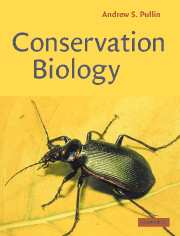Chapter 3 - The human impact
Published online by Cambridge University Press: 05 June 2012
Summary
The natural world is fast disappearing under the influence of human activity. In this chapter we cover the rise in human populations; cultural, agricultural and industrial development; the consequences of these advances on natural systems; and we identify the major threats to biodiversity. These major threats are then described in more detail in Chapters 4 to 6.
By reading this chapter students will gain an understanding of the impact of the growth of the human population on the natural world; the impact of agricultural and industrial activity; and a knowledge of the quantitative impact of humans on species and their habitats.
The rise of human populations
Conservation is often thought of as a twentieth century phenomenon. Something we have only needed within the recent past. But some lessons could have been learnt early in the rise of the human race, as in the example of Easter Island. A small isolated land mass of volcanic origin lying in the Pacific Ocean off the coast of Chile, Easter Island is best known for its stone statues that remain as a record of a culture which has long since passed. The presence of the statues has led to detailed study to try and learn more of the community that built them. Recent pollen analysis by Flenley et al. (1991) suggests that the island was once covered by forests of palm trees, but human colonisation led to deforestation between 1200 and 800 years ago.
- Type
- Chapter
- Information
- Conservation Biology , pp. 53 - 75Publisher: Cambridge University PressPrint publication year: 2002

